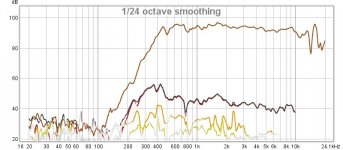My post went goofy so I'll add text here: The first photo is with EQ the second without. Is it better to use CD horns that require high frequency EQ or to find other horns that don't needed it? As can be seen EQ raises both the response and distortion. I like some recordings better with EQ but mostly take it out of the circuit. Maybe I'll experiment with trapping the low region instead of shelfing the upper.
Try some (usual) EQ with a series R-C
C is small ~1uF, R try4. 7 ohm, both in parallel
Before the tweeter or Xover
C is small ~1uF, R try4. 7 ohm, both in parallel
Before the tweeter or Xover
I don't think "flat" ever sounds right. Your "un-EQ'd" response is probably the response I would prefer to listen to, but there isn't right or wrong here. But in practice I always EQ the speakers native response as flat as I can get it as a reference, and then end up using "external" EQ to impose a house curve which tilts smoothly at least 6db down from 100Hz to 10,000Hz. And then I will tweak the upper treble or bass further for different recordings or volume levels. But this with using DSP. If I built passive with analog source I would probably be putting a good EQ unit somewhere in the signal chain. And there's nothing wrong with building "EQ" into the crossover if you are sure that's how you like it. BTW, the gentle FR hump at 1.5K would probably annoy me more than some overall distortion profile. I like a gentle dip there actually.
Whether to use a CD horn or something else is a different issue. I think they are "better" because the power response is flatter, and you can't EQ the power response/directivity. But whatever way you choose to increase the relative SPL at a certain frequency, distortion at that frequency will necessarily increase. If the distortion of your horn/CD is objectionable (to your ears, not your eyes) at the SPL and EQ curve you prefer, you need a different horn or CD or both. And just because a horn is labeled as constant directivity doesn't mean it really is across its entire range. Also CD horns that use diffraction slot throats generally create higher distortion than those that don't.
Whether to use a CD horn or something else is a different issue. I think they are "better" because the power response is flatter, and you can't EQ the power response/directivity. But whatever way you choose to increase the relative SPL at a certain frequency, distortion at that frequency will necessarily increase. If the distortion of your horn/CD is objectionable (to your ears, not your eyes) at the SPL and EQ curve you prefer, you need a different horn or CD or both. And just because a horn is labeled as constant directivity doesn't mean it really is across its entire range. Also CD horns that use diffraction slot throats generally create higher distortion than those that don't.
Inside 16" the horn's center. They still look good at the listening position too.Were the measurements taken at listening position or at 1m outside raised above ground etc ?
Here's one speaker at the listening position. The speaker is toed so I can just see the throat. This is a TD15S crossed to Faital HF140\LTH142 combo. The 450ish dip is the woofers cone\surround resonance, 160ish and bass dips are the room. The horn\driver is hard to beat in room measurements and over -40db THD is darn good FWIW.

I don't know if it would be worth it to go with the 1440 driver to clean up the >10K octave, however that would be a consideration if I were buying today. The TD15S is better if crossed below 400hz but mids are a PITA to choose and use. I'm also considering a more suitable woofer even the pricy TAD 1601B.
The 1uf 15ohm EQ shelf is in place here.
The 1uf 15ohm EQ shelf is in place here.
Personally I would measure outside raised high at 1M and EQ flat there.
Then I would hopefully find an in room response with a gentle downward slope that is close to your un-EQ'd measurement.
Regarding the listening position measurement in post #10, I would be trying to raise the response in the 50 - 180Hz area to get some warmth and 'punch' into the sound .( make a few measurements around the listening position and average them as a starting point) Have a search for the 'Harman curve ' / Floyd Toole stuff .
Cheers,
Rob.
Then I would hopefully find an in room response with a gentle downward slope that is close to your un-EQ'd measurement.
Regarding the listening position measurement in post #10, I would be trying to raise the response in the 50 - 180Hz area to get some warmth and 'punch' into the sound .( make a few measurements around the listening position and average them as a starting point) Have a search for the 'Harman curve ' / Floyd Toole stuff .
Cheers,
Rob.
Makes sense. He can also first try to make dive 5 dB from 250 Hz to 10 KHz... dunno how to do it passive... perhaps trying it only on the high pass filter of the horn story to see if the post 10k hz needs shelving eventually ? The scale of the measurement is huge.
- Home
- Loudspeakers
- Multi-Way
- To EQ or not to EQ that is the question?
